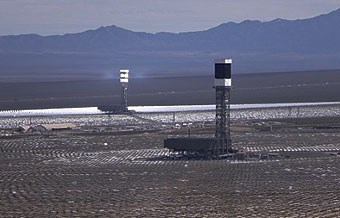
NPS Photo
Solar energy harnesses sunlight to produce energy in the form of heating, cooling, or electricity. Utility-scale solar facilities primarily utilize two types of solar electricity technologies: photovoltaic (PV) or concentrating solar power (CSP).
PV systems are the most common form of solar collectors and are made from silicon or other materials that convert sunlight into electricity. PV panels can be linked together to create systems that are hundred of MW in capactiy. CSP systems produce solar-thermal energy using reflective surfaces to direct sunlight into receivers. The receivers heat fluids (such as oil or molten salt) that generate electricity through a steam turbine or heat engine. Both types of systems require large amounts of land with limited vegetation to maximize direct sunlight reaching the collectors. For this reason, deserts are often desirable locations for solar energy projects.
Please refer to the Department of Energy's Office of Energy Efficiency and Renewable Energy websites for a more detailed description of solar energy technologies.
Technology-Specific Impacts
While all renewable energy projects impact natural, cultural and historical resources, the three key impacts of solar energy projects include water use and contamination, land conversion, and visual impacts.
Water Use and Contamination: PV and CSP systems may require water for ongoing maintenance, cooling, or producing steam for electricity production. Water consumption can change hydrologic patterns, prolong dying, or contaminate or deplete surface or ground water. This can cause fragmentation, increase fish predation, or lead to decreases in dissolved oxygen in the water.
Land Conversion: Utility-scale solar facilities require large areas for collection (ranging from several hundred to thousands of acres) and may compromise lands previously inhabited by wildlife. When developing a site, vegetation must be cleared for the panels to maximize direct sunlight. Clearing vegetation can compact soil, alter drainage, and increase runoff and erosion. Wildlife and plant habitats may also be impacted by security fencing and heat emitted from the solar arrays, causing habitat fragmentation and potentially eliminating or interrupting wildlife/conservation corridors.
Visual Impacts: Utility-scale solar facilities can include many thousands of solar mirrors that reflect sunlight and cause glare, which can alter or damage the natural scenic value of an area. For example, Ivanpah Valley in southeastern California hosts the Ivanpah Solar Electric Generating System, which covers nearly 3,500 acres of desert habitat and employs the use of three 450-foot tall solar power towers. Ivanpah Valley is not only a habitat for various rare desert species, but is also valued for its visual resources and cultural significance to the tribes within that region.
Impacts from construction and development activities, such as the construction of power lines and fugitive dust events, must also be considered because they may affect natural, cultural, and historic resources. Impacts will vary by location and therefore may include, but are not limited to those listed above.
For more information on potential environmental, cultural, and historic resource impacts of solar energy technologies, please see the "Final Programmatic Environmental Impact Statement for Solar Energy Development in Six Southwestern States [11 MB PDF]," or visit the links below.
Related Resources
- Energy 101: Solar PV, U.S. Department of Energy
- Concentrating Solar Power Basics, U.S. Department of Energy
Last updated: September 21, 2016
